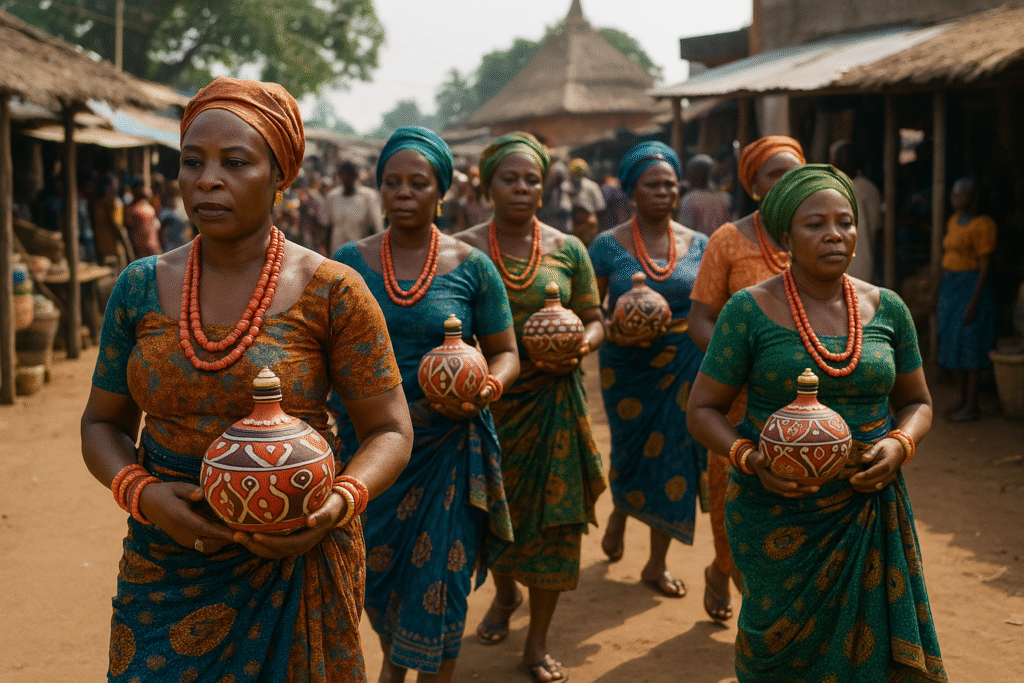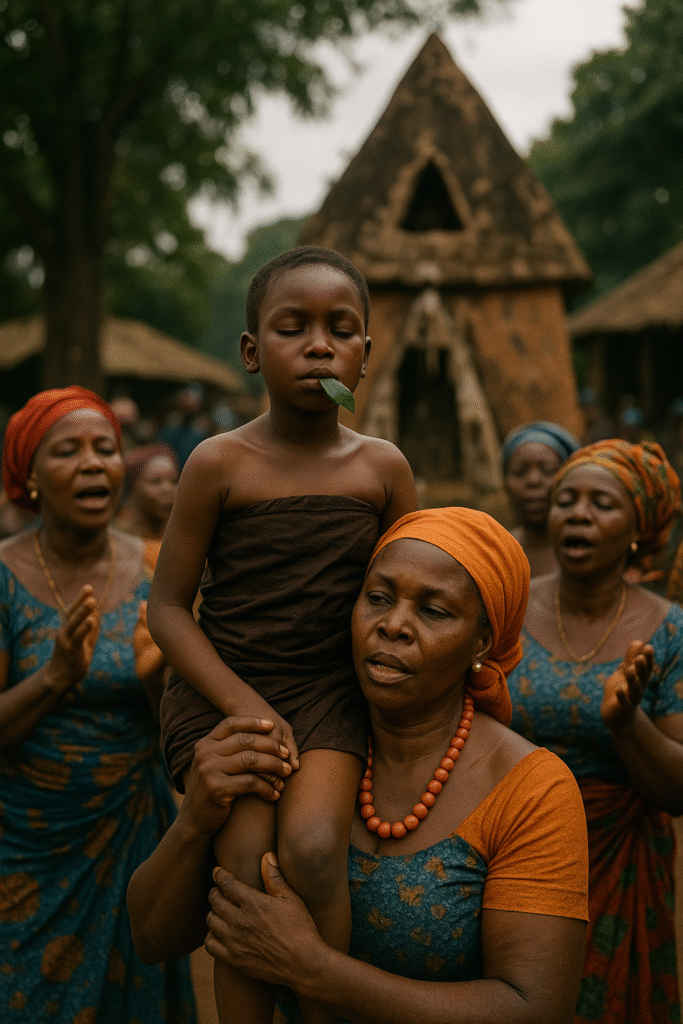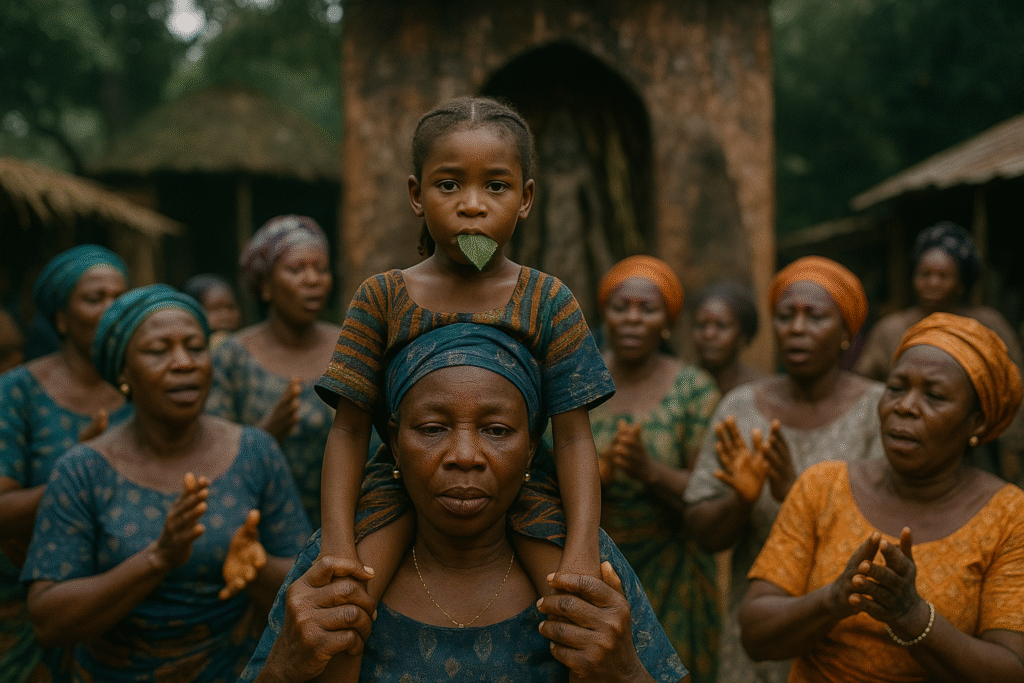The Hidden Nkwọ Onunu Festival That Outsiders Rarely See
Introduction & Quick Background
The Nkwọ Onunu festival is a community-wide Nsukka (Igbo) celebration centered on reverence for the mother/earth principle embodied in “Nkwo,” unfolding around the Nkwo market arena with rites that bind families, daughters, priests, and youth into one sacred rhythm. Outsiders rarely see it up close because attendance and performance protocols are locally governed, the rituals are intimate, and the meanings are layered in Nsukka history and cosmology.
Fact-checked note: Scholars document the festival as a Nsukka-Ideke heritage observance with a structured sequence of offerings, women-led performances, and closing rites.

Where It Happens: Nsukka, Enugu State (Igbo Heartland)
Nsukka lies in today’s Enugu State, southeastern Nigeria. The market day system (Eke, Orie, Afo, Nkwo) frames communal life; the festival centers in the Nkwo market arena, tying sacred time to social space.
When It Happens & Why It Matters
The festival takes place in the early part of the year, often associated with January in local accounts, though communities anchor dates to the indigenous calendar and Nkwo day. It renews bonds with the mother/earth power, asks for protection in the farming season, and affirms social order and memory.
Inside the Nkwọ Onunu festival: Sacred Sequence & Key Rituals
Cosmology: Nkwo as Mother/Earth Divinity (Ala)
In Nsukka thought, Nkwo is revered as the ancestral mother connected to Ala (the earth), guardian of fertility and moral law. Oaths are sworn by her, and sacrifices mark the beginnings/ends of agricultural cycles. This cosmology gives the rites their gravity and explains the community-wide participation.
The “Holy Week” Rhythm and 16-Day Build-Up
Preparation for Onwa Onunu (the season/month of Onunu) is intense. The period is treated as a holy week: people avoid mourning and corrupt practices; shrines are repaired and purified; homes are cleaned; daughters are specially groomed; wrestling may announce eve-of-festival excitement. A 16‑day buildup is documented in local scholarship.
Egwu Okama by the Umuozo: Signaling the Season
A signature opener is Egwu Okama, performed by the Umuozo (tradition-keepers from specific Nsukka quarters). They move through villages, touching cultural sites and stirring memory—elders recall, youths learn. This rite tells everyone the season has arrived. (At the Nkwọ Onunu festival, Egwu Okama is the unmistakable public signal.)
Morning Offerings: Okpa at the Nkwo Shrine
In the morning, households cook okpa (steamed Bambara bean pudding). Portions are brought to the Nkwo shrine for protection; Umuada receive and share them. Newborns are presented with okpa balls in gratitude. (On the day of the Nkwọ Onunu festival, families treat this offering with strict care and timing.).
The Role of Umuada (Daughters of the Land)
The Umuada—women who are daughters of the community—are moral custodians. They arrive in best attire and beaded calabashes, lead songs, and uphold etiquette at the shrine and marketplace. Their presence keeps the celebration orderly and sacred. (During the Nkwọ Onunu festival, Umuada’s authority is highly visible.).
Ọrọme: The Virgin’s Public Rite
One rare and solemn feature is Ọrọme: a girl believed to be a virgin (about 12–15) is carried shoulder-high, silent, with a green leaf in her mouth, then set to dance briefly before the Nkwo shrine and returned home without turning back. It’s linked to fruitfulness and communal blessing. (Another moment in the Nkwọ Onunu festival that outsiders seldom witness is this Ọrọme display.)
Ịgba echi: Coiled Anklets and Womanhood
Ịgba echi features coiled, golden-colored ankle rings (nne-echi for mature/engaged women; ishi‑echi for younger girls). Dressed in fine attire, they process to the arena, cheered and sometimes sprayed with money—publicly signaling beauty, readiness, and hopes for fertility. (The Nkwọ Onunu festival also features ịgba echi as a highly anticipated rite.)
Afternoon Drums: Igede Nkwo and Public Dancing
The Igede Nkwo ensemble (from Umunkporogidi, Nru quarters) opens the afternoon phase; crowds move to its rhythms as the chief priest of Nkwo presides. Music here isn’t mere entertainment—it seals community prayer into collective motion.
Closing Rites: Igo-Nna (Daughters Return to Their Fathers’ Houses)
After five days of festival observances (also tied to Nkwo day), married daughters return to their fathers’ homes with yams, kola, tobacco, and poultry—Igo‑Nna. Families use these gifts for ancestral offerings; daughters receive food/money in return and spend the night at their maiden homes. (At the close of the Nkwọ Onunu festival, Igo‑Nna dramatizes gratitude and lineage ties.)

Dress, Music, Food, and Symbols You’ll Notice
- Dress & Adornment: Beads (aka), wrappers, staffs (abara), coiffed hair, and decorated calabashes. Women’s regalia signals status and ritual role.
- Instruments & Ensembles: Calabash percussion, Igede Nkwo drums, call-and-response songs that move toward the shrine and back to the crowd.
- Foodways: Okpa is emblematic on the festival morning; later, yams and palm wine sustain extended visits and conversations.
- Symbols: Green leaf (silence/chastity in Ọrọme), echi anklets (womanhood/fortune), and shrine-centered movement (petition and gratitude).
Etiquette for Respectful Visitors (If You’re Invited)
- Ask the host family first. Many moments are not for filming or narration by non-initiates.
- Dress modestly; follow Umuada’s cues.
- Offer greetings and a small gift (e.g., kola) when introduced to elders.
- No intrusive questions during rites. Ask later, in private, with a guide.

Cultural Pressures & Continuity: Christianity, Modernity, Youth
Local scholars note that education and Christianity have changed participation levels—especially for Ọrọme and ịgba echi—yet the festival endures as a vessel of identity, memory, and intergenerational learning. Youth music and aesthetics now mingle with ancestral forms, keeping practice alive without breaking taboos.
Safeguarding an Intangible Heritage (Community First)
Safeguarding means community consent, documentation led by Nsukka custodians, and carefully curated public access. Researchers highlight the importance of recognizing women’s leadership and market-day cosmology as the living framework that sustains the rites. (Safeguarding the Nkwọ Onunu festival means prioritizing ritual owners, not spectacle.)
Quick Reference Table
| Element | What It Is | Why It Matters |
|---|---|---|
| Calendar Anchor | Early-year timing on Nkwo day | Links agrarian hopes to sacred time. |
| Venue | Nkwo market arena (Nsukka) | Market-as-shrine, people converge. |
| Central Power | Nkwo as mother/earth, linked to Ala | Moral law, fertility, protection. |
| Openers | Egwu Okama by Umuozo | Announces season; educates youth. |
| Morning Offering | Okpa to the shrine | Family petition and thanks. |
| Women’s Authority | Umuada stewardship | Etiquette, order, ritual continuity. |
| Signature Rites | Ọrọme, ịgba echi | Chastity/fruitfulness; womanhood. |
| Closing Rite | Igo‑Nna | Daughters honor lineage/ancestors. |

FAQ (Practical Answers to Common Questions)
1) Is this festival open to tourists?
Attendance is community-governed. Some public moments are watchable if you’re invited by locals, but several rites are not for photography or outside narration. Respect is key.
2) Why the strong role of women?
In Nsukka practice, Umuada act as moral custodians and ritual stewards. Their songs, protocols, and presence keep the sacred frame intact.
3) What’s the meaning of the green leaf during Ọrọme?
It symbolizes silence and restraint; the girl must not speak or laugh. The rite seeks blessing and fruitfulness for her and the community.
4) What are echi anklets?
Coiled, golden-colored ankle rings highlighting womanhood and readiness. Types (nne‑echi, ishi‑echi) reflect status/age.
5) Why is okpa important on the morning of the festival?
Families cook okpa and take portions to the Nkwo shrine for protection and thanks, reinforcing family-shrine ties.
6) Does the festival always occur in January?
Local sources mention January; scholarship also frames it as early-year and Nkwo-day anchored, reflecting the indigenous calendar rather than fixed Gregorian dates.
7) How long does the build-up last?
A ritual build-up of about 16 days (treated as a holy week) is recorded, with moral restraints, shrine repairs, and rehearsals.
8) What closes the cycle?
Igo‑Nna, when married daughters return with gifts to their fathers’ homes; offerings are made for ancestors, and daughters receive provisions in return.
Conclusion
What outsiders seldom witness is how seamlessly market time, women’s stewardship, family offerings, and youth performances fuse into one living tradition. Seen from within, this celebration is not a staged spectacle; it’s a year-opening covenant—with Nkwo, with the ancestors, and with one another.
you might also like : 7 Incredible Nsukka Masquerade Traditions You’ve Never Heard Of




